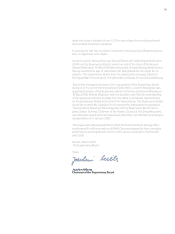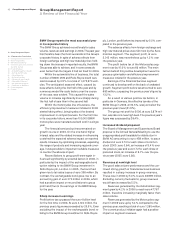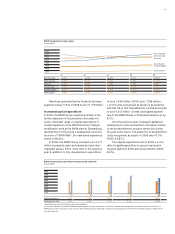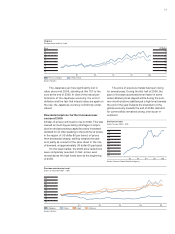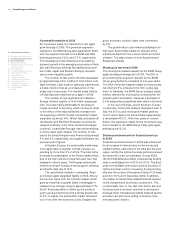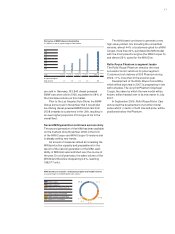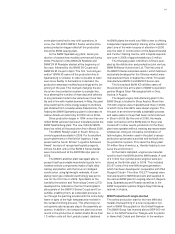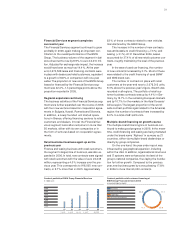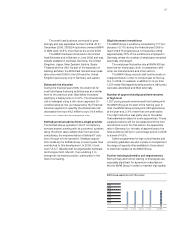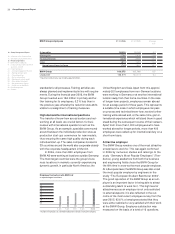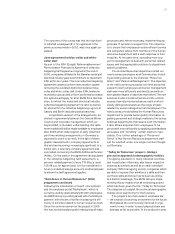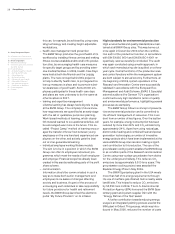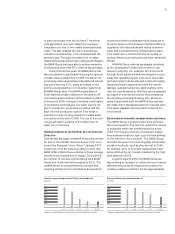BMW 2006 Annual Report Download - page 20
Download and view the complete annual report
Please find page 20 of the 2006 BMW annual report below. You can navigate through the pages in the report by either clicking on the pages listed below, or by using the keyword search tool below to find specific information within the annual report.19
entire plant switched to two-shift operations. In
June, the 100,000th BMW 3 Series vehicle since
series production began rolled off the production
line at the BMW Leipzig plant.
At the BMW Spartanburg plant, series pro-
duction
of several new models commenced during
2006. Production of the BMW Z4 Roadster and
BMW Z4 M Roadster started at the beginning of
the year, followed by the BMW Z4 Coupé and
BMW Z4 M Coupé in April. The first “second
gen-
eration” BMW X5 came off the production line in
Spartanburg in October. In order to be able to react
even more flexibly to fluctuations in demand, the
production area was modified accordingly at the be-
ginning of the year. This involved changing the pre-
vious two-line production system to a single-line,
thus allowing the number of manufactured vehicles
of any particular model to be varied even more flexi-
bly and in line with market demand. In May, the paint
shop switched its entire energy supply to methane
gas obtained from a nearby waste disposal site, thus
helping the BMW Spartanburg plant to decrease its
carbon dioxide emissions by 53,593 tons in 2006.
Since production began in 1994, more than one
million BMW vehicles have been manufactured at the
BMW Spartanburg plant. The one-millionth BMW
brand car rolled off the production line in March 2006.
The BMW Rosslyn plant in South Africa re-
ceived a special accolade in 2006. For its excellent
accomplishments in the field of logistics, it was
presented the South African “Logistics Achievers
Award” by a jury of recognised logistics experts.
Almost 54,800 units of the BMW 3 Series Sedan
were manufactured at the BMW Rosslyn plant in
2006.
The BMW Landshut plant was again able to
present itself as a reliable manufacturing site for in-
novative
vehicle components made of light alloy
casting and plastics, with the focus on intelligent
construction using lightweight materials. A com-
pletely new type of plastics technology was put to
use for the first time in 2006. Specialists at the
Landshut Innovation and Technology Centre (LITZ)
developed the material for the front thermoplastic
side panels of the BMW 3 Series Coupé and Con-
vertible, enabling them, as a standard process, to
run through the painting process with the entire body
frame in spite of the high temperatures involved in
the surface finishing process. This effectively cut
out a previously necessary step in the assembly se-
quence. In addition, the component plant set a new
record in the production of cardan shafts. More than
1.3 million units left the Landshut plant, destined
for BMW plants the world over. With a view to offering
independent apprenticeship training at the Landshut
plant, one of the main focuses of attention in 2006
was the start of construction of the
Apprenticeship
and
Further Training Centre, with a capital expendi-
ture sum in 2006 of approximately euro 3 million.
The Shenyang plant in Northern China is oper-
ated by the distribution and production joint venture,
BMW Brilliance Automotive Ltd. The first units of
the BMW 5 Series extended-version, which has been
exclusively developed for the Chinese market, were
manufactured there in September 2006.This plant
manufactures BMW 3 and BMW 5 Series cars.
The first revised BMW X3 vehicles came off
the production line at the plant of BMW cooperation
partner Magna Steyr Fahrzeugtechnik in Graz,
Austria, in August.
The largest engine manufacturing plant in the
BMW Group is located in Steyr, Austria. More than
703,000 engines were manufactured there in 2006,
of which more than 68 % were diesel engines. The
first part of an environmentally sustainable process
and waste water concept had been commissioned
in Steyr in 2005. By the end of 2006, the waste
water connection at the BMW plant in Steyr was
closed off: in other words, production at the Steyr
plant now operates without creating any waste water
whatsoever. Using an innovative combination of
technologies, the water used in the plant’s various
production processes is purified and fed back into
the production system. This saves the Steyr plant
30 million litres of water p.a., thereby helping to con-
serve the environment.
At the Hams Hall plant, engines are manufac-
tured for both the BMW and the MINI brands. A total
of 217,434 four-cylinder petrol engines were pro-
duced at the British plant in 2006. This included
25,157 units of the new MINI engine generation,
which has been developed in cooperation with PSA
Peugeot Citroën. The other 192,277 engines were
manufactured for BMW brand cars and supplied to
the various BMW plants in Leipzig, Munich, Regens-
burg, Spartanburg and Rosslyn as well as to the
BMW cooperation partner, Magna Steyr Fahrzeug-
technik, in Austria.
MINI Production Triangle started
The series production start for the new MINI also
heralds the beginning of a new cooperation net-
work
of BMW Group plants in the United Kingdom.
The BMW Group has invested almost GBP 200 mil-
lion in the MINI Production Triangle with its plants
in Hams Hall, Oxford and Swindon. In the medium


